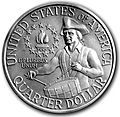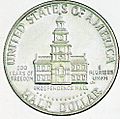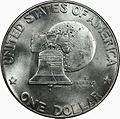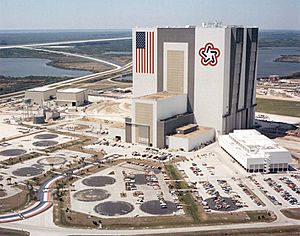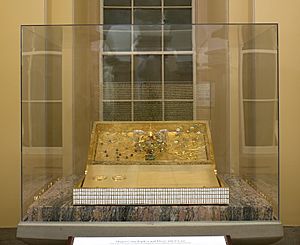United States Bicentennial facts for kids
Quick facts for kids United States Bicentennial |
|
|---|---|
 |
|
| Date(s) | April 1, 1975 – July 4, 1976 |
| Location(s) | United States of America |
| Previous event | Sesquicentennial (1926) |
| Next event | Semiquincentennial (2026) |
| Activity | 200th anniversary of the adoption of the Declaration of Independence |
| Organised by | American Revolution Bicentennial Commission (1966–73) American Revolution Bicentennial Administration (1973–76) |
The United States Bicentennial was a huge celebration across America in the mid-1970s. It honored the 200th birthday of the United States of America. The main event happened on Sunday, July 4, 1976. This was exactly 200 years after the Declaration of Independence was adopted. This important document was approved by the Founding Fathers at the Second Continental Congress.
Contents
How the Bicentennial Began
Americans have always celebrated the country's founding. It's a way to show patriotism and remember important moments. Plans for the Bicentennial started on July 4, 1966. That's when Congress created the American Revolution Bicentennial Commission.
At first, they wanted one big event, like a world's fair, in Philadelphia or Boston. But after many discussions, the Commission decided against a single event. So, in 1973, Congress changed things. They created the American Revolution Bicentennial Administration (ARBA). This group's job was to encourage and help local communities plan their own celebrations. The Bicentennial happened after a challenging time for the country. It focused on themes of new beginnings and traditional values.
Special Coins and Stamps
To celebrate, special coins were made. These included quarters, half dollars, and dollars. They were minted in 1975 and 1976. Each coin had a special design on its back.
-
Reverse of the Bicentennial quarter, minted 1975–1976.
The Bicentennial Logo
The official Bicentennial logo was designed by Bruce N. Blackburn. It featured a white five-point star inside a stylized red, white, and blue star. Around it, the words "American Revolution Bicentennial 1776–1976" were written. This logo appeared on many things. It was on postage stamps and souvenirs. It even flew as a flag at government buildings. NASA painted the logo on its huge Vehicle Assembly Building at the Kennedy Space Center. It stayed there until 1998.
Big Events in 1975
Official Bicentennial events started on April 1, 1975. The American Freedom Train began its journey in Wilmington, Delaware. It traveled over 25,000 miles through 48 states for 21 months.
On April 18, 1975, President Gerald Ford visited Boston. He lit a third lantern at the historic Old North Church. This symbolized America's third century. The next day, he gave a speech in Concord, Massachusetts. He spoke at the Old North Bridge, where the "shot heard round the world" was fired. This marked 200 years since the Battles of Lexington and Concord, which started the American Revolution.
On December 31, 1975, President Ford spoke to the American people. He did this through radio and TV. He signed a special statement. It honored the Founding Fathers of the United States and their ideas. These ideas included dignity, equality, government by representation, and liberty.
Big Events in 1976
The year 1976 was full of celebrations. There were huge fireworks shows in major cities. President Ford watched the display in Washington, D.C., which was shown on TV. A large group of tall sailing ships gathered. They met first in New York City on Independence Day. Then, about a week later, they sailed to Boston. These parades of ships were called Operation Sail. Millions of people watched them. The ships docked, and people could tour them. Their crews enjoyed parties and celebrations on shore.
New York City Celebrations
Besides the tall ships, navies from many countries sent warships to New York Harbor. They had an International Naval Review on the morning of July 4. President Ford sailed on the USS Wainwright to review the ships. He received salutes from each one. The review ended near Liberty Island.
Boston's Symbolic Protest
In Boston, some people threw packages into Boston Harbor. These packages were labeled with names of oil companies. This was a symbolic protest against corporate power. It was done in the style of the original Boston Tea Party.
Washington D.C. Festivities
Johnny Cash was the Grand Marshall of the U.S. Bicentennial parade in Washington, D.C.

Queen Elizabeth II and Prince Philip visited the United States. They toured the country and attended Bicentennial events with President and Mrs. Ford. Their visit included stops in Philadelphia, Washington, D.C., and other cities.
In Washington, D.C., the Smithsonian Institution opened a special exhibit. It looked like the 1876 Centennial Exposition. Many items were from that earlier fair, which celebrated America's 100th birthday. The Bicentennial Festival of American Folklife also took place. It featured scholars, artists, and performers. The National Air and Space Museum also opened its new building on July 1, 1976.
Philadelphia's Special Gift
While in Philadelphia on July 6, 1976, Queen Elizabeth presented a special gift. It was the Bicentennial Bell from the British people. This bell is a copy of the Liberty Bell. It was made at the same foundry. It says: "For the People of the United States of America from the People of Britain 4 July 1976 LET FREEDOM RING."
Fun in Los Angeles
Disneyland and The Magic Kingdom at Walt Disney World had a parade called America on Parade. It celebrated American history and culture. It ran twice daily from June 1975 to September 1976.
Los Angeles also had its own Bicentennial Parade. There was a big pageant at the Los Angeles Memorial Coliseum. Many local celebrations took place too. People painted mailboxes and fire hydrants red, white, and blue. There was a strong feeling of patriotism across the nation. People felt that a challenging period for the country was ending.
NASA's Bicentennial Role
NASA celebrated the Bicentennial with a science and technology exhibit. It was housed in domes near the Vehicle Assembly Building (VAB). An American flag and the Bicentennial logo were painted on the VAB. NASA had planned for its Viking 1 spacecraft to land on Mars on July 4. But the landing was delayed to July 20. This was the anniversary of the Apollo 11 moon landing. NASA also held a ceremony for the first Space Shuttle. It was named "Enterprise" after the ship in Star Trek.
Other Ways America Celebrated
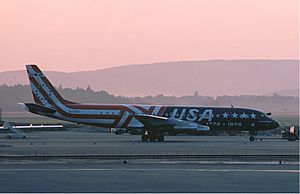
Many products were sold in red, white, and blue packages. Companies paid a fee to use the official Bicentennial logo. Railroads painted locomotives in patriotic colors. Many were numbered 1776 or 1976. Military units also decorated aircraft with special designs.
The New Jersey Lottery had a "Bicentennial Lottery." The winner received $1,776 per week for 20 years.
The Super Bowl X in January 1976 also celebrated the Bicentennial. Players wore a special logo patch on their jerseys. The halftime show was called "200 Years and Just a Baby: A Tribute to America's Bicentennial."
The U.S. Olympic Committee tried to host the 1976 Summer and Winter Olympic Games. Los Angeles bid for the Summer Olympics but lost. Denver was chosen for the Winter Olympics, but voters rejected funding. So, no Olympics were held in the U.S. in 1976. However, Lake Placid hosted the 1980 Winter Olympics. Los Angeles hosted the 1984 Summer Olympics.
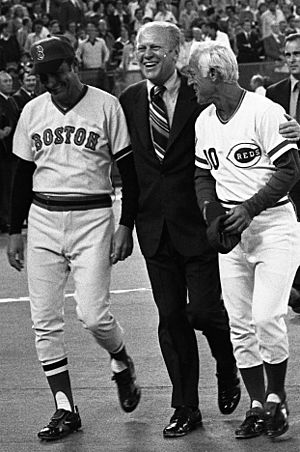
Philadelphia hosted many sports events in 1976. These included the NBA All-Star Game, NHL All-Star Game, NCAA Final Four, and the Major League Baseball All-Star Game. President Ford even threw out the first pitch at the baseball game.
George Washington was given a special honor. On January 19, 1976, he was made General of the Armies of the United States. This made him the highest-ranking military officer in U.S. history.
The Bicentennial Wagon Train Pilgrimage began in June 1975. It traveled from Blaine, Washington to Valley Forge, Pennsylvania. It followed old trade routes across the country.
Karen Steele was the first baby born on July 4, 1976. She was called the "Bicentennial Baby." She appeared on TV shows and received honors from President Ford.
The Bicentennial on TV and Film
TV Shows and Cartoons
Many TV programs aired on July 3–4, 1976, to celebrate. These included long shows with hosts like Walter Cronkite and John Chancellor. There were also special entertainment programs.
The Bicentennial Minute was a series of short videos shown on CBS from 1974 to 1976. They marked the occasion with historical facts.
Schoolhouse Rock!, an educational cartoon series, created "America Rock." These shorts taught about American history and government. Popular segments included "I'm Just a Bill" and "The Preamble."
In 1974, CBS aired an Archie cartoon series called The U.S. of Archie. It had 16 episodes.
Movies with a Bicentennial Touch
Hollywood filmmaker John Huston directed a short movie called Independence (1976). It was made for the U.S. National Park Service. It still plays at Independence National Historical Park in Philadelphia.
The 1976 film Rocky also mentioned the Bicentennial. In the movie, Apollo Creed dressed as George Washington and Uncle Sam.
Gifts from Around the World
Several countries gave gifts to the U.S. to show friendship.
From the United Kingdom
The United Kingdom loaned one of the four existing copies of Magna Carta. This important historical document was displayed in the U.S. Capitol. It was in a special case made of gold, steel, and jewels. The document was shown from June 1976 to June 1977. The case and a gold copy of the document are still on display.
From Canada and France
Canada created a book called Between Friends/Entre Amis. It was a photo essay about life along the U.S.-Canada border. Copies were given to libraries and to President Gerald Ford.
The government of France and the Musée du Louvre put together an art exhibit. It traveled to Detroit and New York City. The exhibit, called French Painting 1774–1830: The Age of Revolution, included 149 works by 94 French artists. Many had never been seen outside France before.
From Japan and Spain
Japan built and furnished the Terrace Theatre at the Kennedy Center in Washington. Japan also donated 53 bonsai trees to the U.S. National Arboretum.
King Juan Carlos I and Queen Sofía of Spain gave sculptures as gifts. These included a statue of Bernardo de Gálvez, an American Revolutionary War hero. They also gave a statue of Don Quixote, a famous Spanish story character. Spain also had an exhibit of eight Goya paintings at the National Gallery of Art.
From Norway
King Olav V and the Norwegian Government established the Vinland National Health Sports Center in Loretto, Minnesota.
Gallery
- Celebrating the United States Bicentennial
-
Italian tall ship Amerigo Vespucci in New York Harbor during the celebration.
- United States Bicentennial Era Postage Stamps
-
John Trumbull's 1818 oil painting showing the Declaration of Independence being presented to the Continental Congress.
-
Archibald Willard's 1875 painting The Spirit of '76 showing a fife player and two drummers leading the Continental Army.
-
Patriots using a printing press to examine a colonial pamphlet.
-
A 1773 picture of the Boston Tea Party, where tea was dumped into Boston Harbor.
-
Haym Salomon was a colonial paymaster who helped fund the American Revolution.
-
Peter Francisco at the Battle of Camden, where he reportedly moved a 1000-pound cannon.
-
Salem Poor at the Battle of Bunker Hill, credited with wounding a British officer.
-
Sybil Ludington is said to have ridden through the night to warn minutemen about British soldiers.
-
Patriots honoring a drummer who marched into battle.
-
Patriots honoring post riders who delivered mail on horseback.
- Other Commemorative Items
See also
 In Spanish: Bicentenario de los Estados Unidos para niños
In Spanish: Bicentenario de los Estados Unidos para niños


